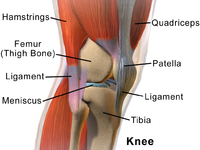
Photo from wikipedia
CLINICAL SCENARIO Knee pain and limited knee range of motion (ROM) are among the most common conditions found in individuals who report lower body health-related issues. Factors such as weight… Click to show full abstract
CLINICAL SCENARIO Knee pain and limited knee range of motion (ROM) are among the most common conditions found in individuals who report lower body health-related issues. Factors such as weight gain, lack of mobility, balance issues, and pain can lead to a more sedentary lifestyle, which, in turn, causes knee stiffness or knee limited ROM. As a result, the patient will be at higher risk of osteoporosis, patellofemoral pain syndrome, reduced quadriceps strength, heart disease, and even depression. CLINICAL QUESTION Is mobilization with movement (MWM) an effective method of treatment for reducing knee pain and increasing knee ROM in individuals being treated for knee pain and limited knee ROM? SUMMARY OF KEY FINDINGS (1) The literature searched were peer-reviewed articles that investigated the effects of MWM as a therapy to reduce knee pain and increase knee ROM. (2) MWM was shown to be an effective treatment for reducing knee pain and increasing knee ROM. CLINICAL BOTTOM LINE There is conclusive evidence that MWM is an effective method of treatment for reducing knee pain and increasing knee ROM in individuals who experience knee pain and knee limited ROM. STRENGTH OF RECOMMENDATION Grade ("A") evidence exists showing that MWM therapy results are greater when performed either alone or in combination with a current conventional therapy for decreasing knee pain and increasing knee ROM.